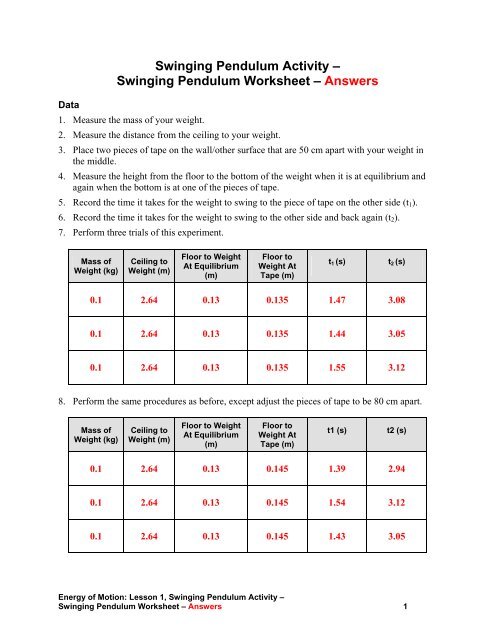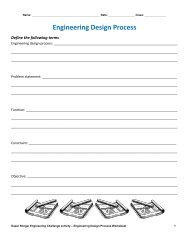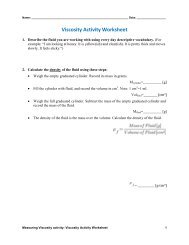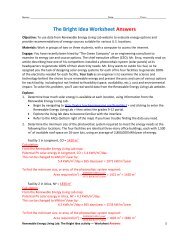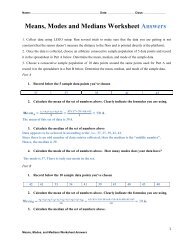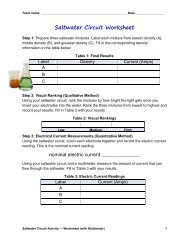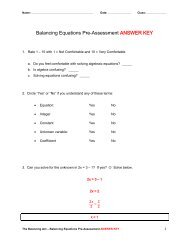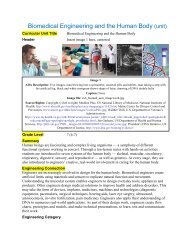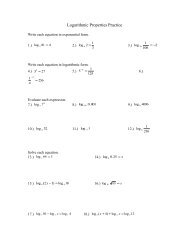Swinging Pendulum Worksheet Answers (pdf) - Teach Engineering
Swinging Pendulum Worksheet Answers (pdf) - Teach Engineering
Swinging Pendulum Worksheet Answers (pdf) - Teach Engineering
Create successful ePaper yourself
Turn your PDF publications into a flip-book with our unique Google optimized e-Paper software.
Data<br />
<strong>Swinging</strong> <strong>Pendulum</strong> Activity –<br />
<strong>Swinging</strong> <strong>Pendulum</strong> <strong>Worksheet</strong> – <strong>Answers</strong><br />
1. Measure the mass of your weight.<br />
2. Measure the distance from the ceiling to your weight.<br />
3. Place two pieces of tape on the wall/other surface that are 50 cm apart with your weight in<br />
the middle.<br />
4. Measure the height from the floor to the bottom of the weight when it is at equilibrium and<br />
again when the bottom is at one of the pieces of tape.<br />
5. Record the time it takes for the weight to swing to the piece of tape on the other side (t 1 ).<br />
6. Record the time it takes for the weight to swing to the other side and back again (t 2 ).<br />
7. Perform three trials of this experiment.<br />
Mass of<br />
Weight (kg)<br />
Ceiling to<br />
Weight (m)<br />
Floor to Weight<br />
At Equilibrium<br />
(m)<br />
Floor to<br />
Weight At<br />
Tape (m)<br />
t 1 (s)<br />
t 2 (s)<br />
0.1 2.64 0.13 0.135 1.47 3.08<br />
0.1 2.64 0.13 0.135 1.44 3.05<br />
0.1 2.64 0.13 0.135 1.55 3.12<br />
8. Perform the same procedures as before, except adjust the pieces of tape to be 80 cm apart.<br />
Mass of<br />
Weight (kg)<br />
Ceiling to<br />
Weight (m)<br />
Floor to Weight<br />
At Equilibrium<br />
(m)<br />
Floor to<br />
Weight At<br />
Tape (m)<br />
t1 (s)<br />
t2 (s)<br />
0.1 2.64 0.13 0.145 1.39 2.94<br />
0.1 2.64 0.13 0.145 1.54 3.12<br />
0.1 2.64 0.13 0.145 1.43 3.05<br />
Energy of Motion: Lesson 1, <strong>Swinging</strong> <strong>Pendulum</strong> Activity –<br />
<strong>Swinging</strong> <strong>Pendulum</strong> <strong>Worksheet</strong> – <strong>Answers</strong> 1
Calculations and Results<br />
1. Subtract t 2 from t 1 and calculate the average value for both set of trials.<br />
Tape Separation: 50 cm<br />
Tape Separation: 80 cm<br />
t 2 – t 1 (s)<br />
1.61<br />
1.61<br />
1.57<br />
Avg: 1.597<br />
t 2 – t 1 (s)<br />
1.55<br />
1.58<br />
1.62<br />
Avg: 1.583<br />
2. Calculate the Potential Energy (PE) of the weight at the initial piece of tape for the two<br />
different tape separation values.<br />
First Set<br />
PE = m*g*h where m = mass, g = gravity, h = height<br />
PE = 0.1 kg * 9.81 m/s 2 * 0.135 m<br />
PE = 0.1324 Joules<br />
Second Set<br />
PE = 0.1 kg * 9.81 m/s 2 * 0.145 m<br />
PE = 0.1422 Joules<br />
3. Calculate the Kinetic Energy (KE) and theoretical velocity of the weight at the bottom of<br />
its swing for the two tape separation values.<br />
Total Energy = Kinetic Energy (KE) + Potential Energy (PE) = Initial PE<br />
At Equilibrium: First Set<br />
PE = 0.1 kg * 9.81 m/s 2 * 0.13 m<br />
PE = 0.1275<br />
Initial PE = KE + PE<br />
0.1324 Joules = KE + 0.1275 Joules<br />
KE = 0.0049<br />
At Equilibrium: Second Set<br />
Initial PE = KE + PE<br />
0.1422 Joules = KE + 0.1275 Joules<br />
KE = 0.0147 Joules<br />
Energy of Motion: Lesson 1, <strong>Swinging</strong> <strong>Pendulum</strong> Activity –<br />
<strong>Swinging</strong> <strong>Pendulum</strong> <strong>Worksheet</strong> – <strong>Answers</strong><br />
2
4. Calculate the measured velocity of the weight and compare it with the theoretical velocity<br />
by using percent error.<br />
First Set<br />
Theoretical Velocity – Use the Kinetic Energy value to find theoretical velocity<br />
KE = ½ * m * v2<br />
0.0049 Joules = ½ * 0.1 kg * v2<br />
v = 0.3130 m/s<br />
Measured Velocity – Use the Measured differences in times and the distance<br />
traveled by the weight<br />
v = distance / Time<br />
v = 0.50 m / 1.597<br />
v = 0.3131 m/s<br />
Percent Error = (v measured – v theoretical ) / v theoretical * 100%<br />
Percent Error = 0.032 %<br />
Second Set – repeat calculations from first set with the second set values<br />
Tape Separation: 50 cm<br />
Potential<br />
Energy (Joules)<br />
Kinetic Energy<br />
(Joules)<br />
Theoretical<br />
Velocity (m/s)<br />
Measured<br />
Velocity (m/s)<br />
Percent Error<br />
0.1324 0.0049 0.3130 0.3131 0.032 %<br />
Tape Separation: 80 cm<br />
Potential<br />
Energy (Joules)<br />
Kinetic Energy<br />
(Joules)<br />
Theoretical<br />
Velocity (m/s)<br />
Measured<br />
Velocity (m/s)<br />
Percent Error<br />
0.1422 0.0147 0.5422 .5053 6.82 %<br />
Energy of Motion: Lesson 1, <strong>Swinging</strong> <strong>Pendulum</strong> Activity –<br />
<strong>Swinging</strong> <strong>Pendulum</strong> <strong>Worksheet</strong> – <strong>Answers</strong> 3
5. Calculate the Theoretical period of the pendulum. Why do you only have to perform this<br />
calculation once and not for both of sets of trials.<br />
Where T = period, l = length of pendulum, g = gravity<br />
T = 2Π * (2.64 m / 9.81 m/s 2 ) ½<br />
T = 3.259 s<br />
This calculation only has to be performed once because the period of the pendulum<br />
is not dependent on how high up the object at the end of the pendulum begins its<br />
swing. The higher up it is, the faster it travels to the other side; the lower it is, the<br />
slower it travels. The period is only dependent on the length of the pendulum.<br />
6. What was the measured period for each set of trials and what was the percent error for<br />
each case?<br />
First Set<br />
Measured Period = Avg. t 2 value<br />
Measured Period = (3.08 s + 3.05 s + 3.12 s) / 3<br />
Measured Period = 3.083 s<br />
Percent Error = (3.259 – 3.083) / 3.259 * 100 %<br />
Percent Error = 5.39 %<br />
Second Set – repeat calculations with second set values<br />
Theoretical<br />
Period (s)<br />
Measured<br />
Period – 1st set<br />
(s)<br />
Measured<br />
Period – 2nd set<br />
(s)<br />
Percent Error –<br />
1st set<br />
Percent Error –<br />
2nd set<br />
3.259 3.083 3.037 5.39 % 6.81 %<br />
Further Learning<br />
7. Account for the percent error between your measured periods and your theoretical<br />
periods.<br />
In this experiment, we did not consider wind resistance or the resistance on the<br />
swing from the tape. This resistance causes the swings to be shorter than they<br />
would be with no resistance. However, the swings will also be slower because of<br />
this resistance. Therefore, the error is smaller than would be expected from the<br />
resistances. Taking this fact into consideration, the error is also on account of<br />
Energy of Motion: Lesson 1, <strong>Swinging</strong> <strong>Pendulum</strong> Activity –<br />
<strong>Swinging</strong> <strong>Pendulum</strong> <strong>Worksheet</strong> – <strong>Answers</strong> 4
inaccurate measurements made throughout the experiment as a result of not<br />
having state-of-the-art equipment.<br />
8. Calculate how long you would have to make a pendulum so that it would have a<br />
period of one second.<br />
T = 2Π * (L / g) ½<br />
1 s = 2Π * (L / 9.81 m/s 2 ) ½<br />
L = 0.2485 m<br />
9. Based on your calculations and results, would it be more efficient to have your<br />
pendulum with a period of one second swing from a higher height or a lower height?<br />
Explain.<br />
It would be more efficient to have the pendulum swing from a lower height. In<br />
the experiment, there was a greater error in the period of the pendulum when it<br />
started from a higher height. Therefore, starting it at a lower height would<br />
require less external energy to keep the pendulum swinging consistently at a<br />
period of 1 second.<br />
10. You are an engineer working for an amusement park. They have asked you to<br />
develop one of the fastest roller coasters in the U.S., but they also want it to be cost<br />
efficient. Therefore, they do not want to have to use a lot of energy to break the roller<br />
coaster. How would you develop this ride so that it is still easily accessible to the<br />
amusement park guests?<br />
The two components to consider while building this roller coaster are the<br />
potential and kinetic energies of the roller coaster, and the weight of the roller<br />
coaster. The speed at which the roller coaster travels is not affected by the<br />
weight of the roller coaster if it gains all of its speed through a transfer of<br />
potential energy to kinetic. Therefore, a lighter roller coaster can go just as fast<br />
as a heavier one but require less energy to brake. In order to make the roller<br />
coaster travel at a top speed, it would be best to use a combination of potential<br />
energy transferred to kinetic and a launching system. The problem with this<br />
comes at the end of the ride because if the end is at the same place as the<br />
beginning, it will be traveling very fast and require a lot of energy to slow down.<br />
Therefore, we can have the end of the ride be at a higher point than the<br />
beginning so that more kinetic energy is transferred to potential. Then, after the<br />
people get off and there is significantly less weight, a braking system is used to<br />
bring the roller coaster back to the beginning.<br />
Energy of Motion: Lesson 1, <strong>Swinging</strong> <strong>Pendulum</strong> Activity –<br />
<strong>Swinging</strong> <strong>Pendulum</strong> <strong>Worksheet</strong> – <strong>Answers</strong> 5


